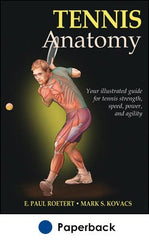Tennis defined by four distinct playing styles
This is an excerpt from Tennis Anatomy by Paul Roetert & Mark S. Kovacs.
Playing Styles
Do you know what your playing style is? Do you like to come to the net and put the ball away with a volley or overhead? Or are you the type of player who likes to outlast your opponent by never missing a ball? Or do you like to hit the ball hard from the baseline, trying to dictate points and go for winners? All three styles can be very effective. Which style you use depends on your skills, personality, and possibly the court surface you play on most frequently. Most coaches categorize players into four different playing styles:
1. Serve and volleyer
2. Aggressive baseliner
3. Counterpuncher
4. All-court player
At the top professional level, the aggressive baseliner is the most prevalent, followed by the all-court player. The traditional serve and volleyer and the stereotypical counterpuncher are no longer preferred playing styles on either the men's or women's tours. However, tennis players at other levels can be seen playing each of these different styles.
The serve and volleyer relies on the serve to help dictate the point. After the serve, she explodes forward to the net. Typically, a serve and volleyer moves forward 20 to 40 percent more than a counterpuncher or an aggressive baseliner and about 20 percent more than an all-court player. Because of this forward movement, a serve and volleyer often finds herself at the net, trying to finish the point. Good volley technique is imperative and requires excellent leg strength, particularly in the quadriceps, gluteus maximus, and gastrocnemius. Strong leg muscles are key, especially for hitting low volleys that require significant knee flexion. Functional flexibility is very important to the serve and volleyer because she is required to get very low to the ground dozens of times throughout the match. Similarly, flexibility of the wrist is helpful, especially in reaching for volleys that stress the end range of the joint. This flexibility needs to be trained regularly.
The aggressive baseliner is more comfortable hitting groundstrokes but is also looking to put pressure on his opponent by hitting hard, aggressive strokes. This player's goal is to move less than the counterpuncher, and he prefers to move inside the court and take balls earlier to reduce the opponent's time between strokes. Muscular strength and endurance are required, but overall power is the major physical component that helps the aggressive baseliner dictate points. Having a major weapon such as a big forehand or strong two-handed backhand is very beneficial. Powerful strokes require strength as well as speed. Training exercises should take this into account. Exercises for the lower body and midsection should be very similar to those mentioned for players with other styles, but a greater emphasis on upper body power is helpful. The muscles of the chest and front of the shoulders are important for producing force, but don't neglect the muscles of the back of the shoulders and upper back. They help protect the shoulder complex and prevent injury.
The goal of the counterpuncher is to chase down every ball and make sure the opponent has to hit many balls each rally to win any points.This game style is based on great side-to-side movement and stroke consistency.The counterpuncher moves laterally 60 to 80 percent of the time. Often she will stretch out to hit open-stance forehands or backhands. Therefore, it is critical to train the abductors and adductors as well as the muscle groups mentioned for the serve and volleyer in a well-rounded training program. This includes training flexibility as well as strength. The counterpuncher must depend on speed, quickness, and the ability to change direction since she may not often put the ball away for a winner. This type of game style is most effective on slower courts. Muscular endurance of the upper and lower body is critical. The obliques must be trained to assist in the rotational movements of all groundstrokes since the counterpuncher hits so many strokes, most with an open stance. Also, when playing great defense, the counterpuncher may hit many strokes when on one leg, out of position, or off balance. Therefore, it is imperative to train for these situations on the court by performing single-leg activities and training in unstable or irregular environments.
The all-court player looks to be aggressive when hitting groundstrokes but is also happy to follow aggressive shots to the net to finish points. All shots, from serves to groundstrokes to volleys, require equal attention in training. In addition, significant time should be spent on the transition game, training for shots that help the all-court player get to the net. The all-court player should regularly practice approach shots, such as a big forehand or slice backhand hit from half court, and follow each shot to the net. These shots require excellent movement and positioning, most often with a more closed stance than regular groundstrokes. Exercises for both the upper and lower body are beneficial, especially exercises that help develop weight transfer and movement into the court such as the spider drill and the split step with stimulus drill in chapter 9. It is important to train all muscle groups. The main focus should be on balancing between left and right, front and back, and upper and lower body.
Read more about Tennis Anatomy by Paul Roetert and Mark Kovacs.
More Excerpts From Tennis Anatomy

Get the latest insights with regular newsletters, plus periodic product information and special insider offers.
JOIN NOW


